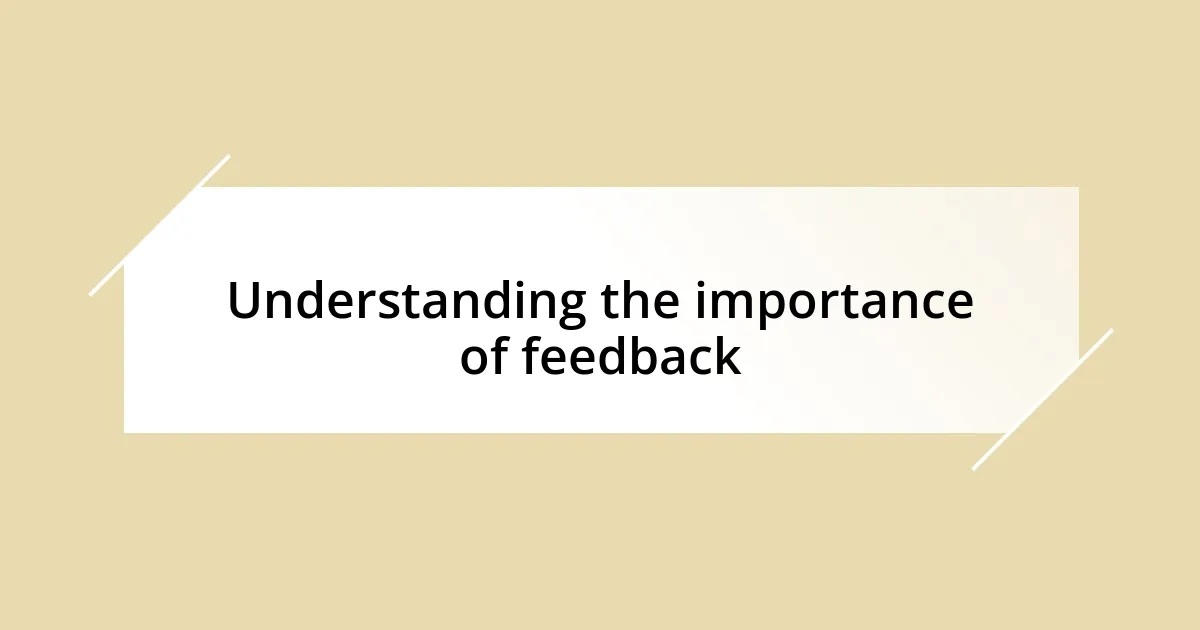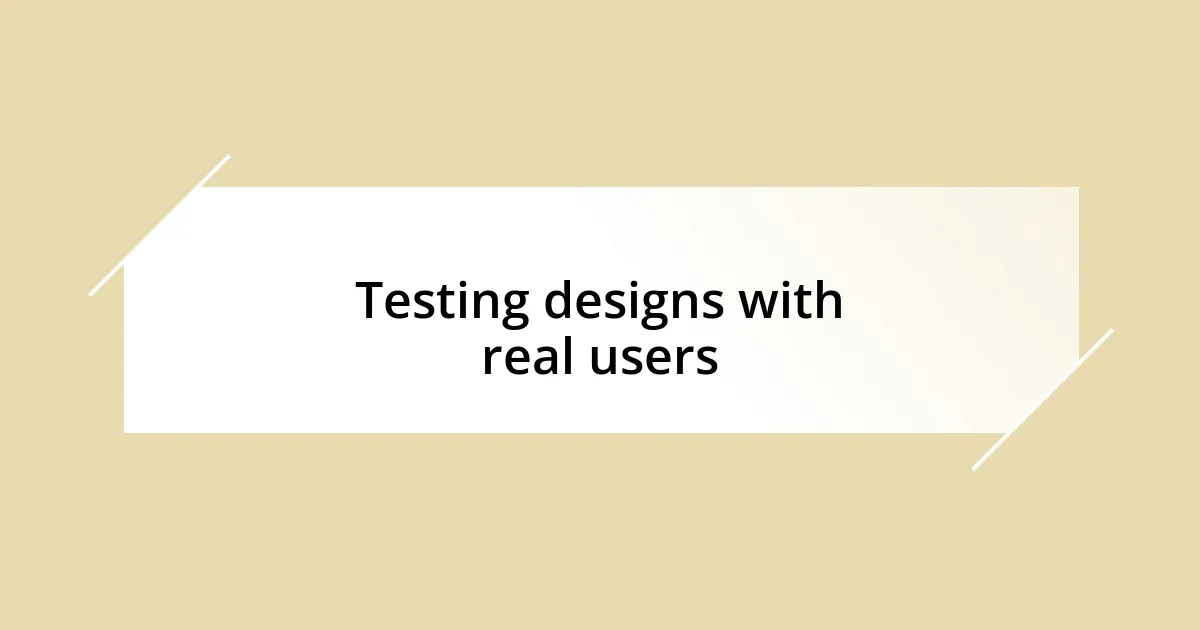Key takeaways:
- Feedback is essential for understanding user needs and refining designs, turning criticism into valuable insights.
- Engaging with diverse feedback sources, including users and colleagues, enriches the design process and leads to holistic improvements.
- Iterating based on user testing can expose design flaws and lead to transformative changes that enhance clarity and user experience.
- Successful design transformations often stem from active listening to users, illustrating the importance of collaboration and adaptability.

Understanding the importance of feedback
Feedback serves as a vital compass in the design process, guiding us toward our target audience’s needs and preferences. I remember a time when my initial design was met with unexpected criticism; at first, it stung. However, I realized that their insights were invaluable—they highlighted aspects I hadn’t even considered. Isn’t it fascinating how a few pointed words can lead to clarity?
When I look back, some of my best ideas emerged from the feedback I received. For instance, a user once mentioned how a color choice felt overwhelming. In response, I explored a calmer palette, which unlocked a more engaging and inviting design. Have you ever felt that shift when something finally clicks?
Understanding feedback also fosters a strong connection with users, transforming them from passive observers into active participants in the design journey. By involving them in this way, I learned to consider their perspectives and how my designs could resonate on a deeper level. It’s like having a collaborative partner who helps refine your vision—how empowering is that?

Identifying key feedback sources
Identifying key feedback sources is essential for meaningful design evolution. I recall a project where I underestimated the value of informal feedback from my colleagues. A casual chat over lunch brought up several concerns about user navigation that I hadn’t noticed during my design process. It dawned on me that sometimes the best insights come from a relaxed environment rather than formal review sessions.
When I started reaching out to users directly, the transformation in my designs was remarkable. One user shared that certain features felt confusing, which prompted me to rethink the layout entirely. This experience taught me that approaching feedback with an open mind can unveil hidden opportunities. Have you ever received unexpected insights from a user that completely changed your design outlook?
Combining feedback from various sources creates a holistic view. I made it a practice to engage with beta testers, social media followers, and clients alike. Each group brings a unique perspective, enriching my design with diverse viewpoints. It’s an eye-opening journey to realize how different backgrounds can shape interpretations. Wouldn’t you agree that the more voices contribute to our designs, the stronger the end result?
| Feedback Source | Description |
|---|---|
| Users | Direct input from end-users helps identify specific pain points. |
| Colleagues | Casual conversations can reveal overlooked aspects in the design. |
| Beta Testers | Provides real-world testing to uncover usability issues. |
| Social Media | Engagement can yield insights into audience perceptions and preferences. |

Analyzing feedback for design insights
Analyzing feedback is crucial for unearthing design insights that might not be immediately obvious. One instance that stands out to me was when a client pointed out that our site’s flow felt disjointed. Initially, I felt defensive, but after reflecting on their comments, I recognized a pattern in user interactions that I had missed. This realization transformed my approach, leading me to prioritize a seamless journey for the user.
To harness feedback effectively, I found it helpful to break it down into actionable insights. Here are some strategies I employ:
- Categorize feedback: Organize comments into themes like usability, aesthetics, or functionality. This helps pinpoint specific areas for improvement.
- Create user personas: Understanding the context behind the feedback can clarify whose needs are being addressed.
- Prioritize actionable insights: Focus on feedback that can lead to tangible design changes rather than personal preferences.
By analyzing feedback in this methodical way, I’ve consistently seen designs improve and align more closely with user expectations. It’s almost magical how taking a structured approach to this creative chaos can refine and elevate the entire design process.

Incorporating feedback into design process
Incorporating feedback into the design process is like weaving a tapestry; each thread adds depth to the final piece. One project sticks with me where I incorporated team feedback during the early design stages. A colleague pointed out that my color choices felt too vibrant for the intended mood. Initially surprised, I later realized that the adjustment not only calmed the design but also resonated better with our target audience. Have you ever changed a design element based on someone else’s input and found it improved your vision?
As I continued to integrate feedback, I learned to view it as a continuous conversation. Using tools like feedback loops and design reviews became essential. During one review session, I noticed that what seemed like minor usability issues were actually frustrating users significantly. This shift in perspective helped me pivot from my original concept towards a more user-centered design, which truly invigorated the project. Isn’t it fascinating how fresh eyes can reveal what you might have overlooked?
Embracing feedback also means inviting some discomfort into the process. I recall a time when extensive user testing unveiled that my wireframes were overly complicated. It stung at first, but the exhilaration of crafting a streamlined, intuitive design from their insights was worth the initial blow. By welcoming constructive criticism, I create designs that are not only functional but also resonate with the end-users. Don’t you think that sometimes, stepping back to accept critique can lead to the most rewarding breakthroughs?

Testing designs with real users
Testing designs with real users is a crucial step that I genuinely look forward to. During one project, I organized a session with potential users, observing how they interacted with my designs. Watching their reactions in real time was a blend of excitement and anxiety; it was like peeking into a window I’d been trying to carefully create. I remember one user hesitating at a key navigation point and admitting they didn’t understand where to go next. This single moment sparked an “aha” that it wasn’t just about aesthetics – clarity was paramount.
In my experience, the feedback from real users can be a humbling yet invigorating experience. After one round of testing, I discovered that my color scheme, which I thought was visually striking, actually distracted users from the primary calls to action. I felt that familiar pang of disappointment but quickly realized that this feedback was my guiding star. Isn’t it interesting how sometimes, the designs we adore might not resonate with our audience?
Engaging with users directly not only refines the designs but transforms my perspective on the entire process. I once thought wireframes were mostly about functionality until I listened to users discuss their experiences. Their insights revealed emotional connections I hadn’t anticipated. They didn’t just want a functional website; they craved an experience that felt intuitive and welcoming. This shift in understanding reaffirmed my belief that involving real users early on enriched my designs profoundly. Have you ever had a moment where a user’s feedback changed your entire vision? It’s truly eye-opening.

Iterating based on user testing
Iterating based on user testing can lead to astonishing transformations in design. I recall a session where participants struggled with a toggle feature I thought was innovative. At first, I felt defensive; after all, it seemed so sleek! But, as I watched their puzzled expressions, it became clear that what I viewed as cutting-edge was actually confusing. This revelation pushed me to rethink not just that particular element, but the entire interaction design to ensure clarity and ease of use. Isn’t it interesting how our vision can sometimes cloud our judgment?
In another instance, feedback from user testing forced me to confront my assumptions about user preferences. My initial design emphasized bright, bold graphics that I believed would captivate attention. Much to my surprise, users expressed a preference for something more subdued and elegant. It was a sobering realization that sometimes, what excites us as designers may not resonate with those we’re designing for. Connecting with users in this way taught me to listen deeply and consider their emotional responses, which ultimately shaped a design that felt more intuitive and aligned with their needs.
I also learned the value of patience during the iteration process. In one project, user feedback revealed several tweaks that needed to be made, and I initially felt the pressure to implement changes swiftly. However, I realized that taking the time to reflect on this feedback and prioritize thoughtful revisions led to a much more cohesive final product. Now, I often remind myself that true transformation rarely happens overnight. Have you ever found that taking things step by step allowed for more meaningful changes? Embracing this iterative journey has become one of my favorite parts of design!

Showcasing successful design transformations
Showcasing successful design transformations often comes down to the story behind each change. In one memorable project, I was working on a mobile app interface when a user candidly pointed out how a particular button seemed out of place and wasn’t standing out enough. Initially, I was hesitant, but once I took a step back, I realized their perspective held weight. I adjusted the button’s placement and color, and the positive shift in user engagement was immediate. It struck me how one person’s input could transform a design into something far more impactful.
Another occasion that stands out involved a website overhaul. I had poured my heart into creating a sleek, modern aesthetic, only to hear users express frustration over how the navigation felt buried. Taking their feedback to heart, I reimagined the layout, bringing the navigation to the forefront. The relief on users’ faces during the next testing session was palpable, a powerful reminder that design isn’t just about visuals; it’s about creating pathways for users to seamlessly journey through an experience. Have you ever felt that rush of satisfaction when a design shift instantly resonates with users?
Ultimately, these transformations remind me that feedback is not just critique—it’s a lifeline. In another project, my team was focused on launching a product that I thought was game-changing. However, user feedback indicated they didn’t see the value. Instead of dismissing it, I took a hard look at what we presented and why it didn’t connect. This led us to pivot the messaging and design elements entirely, resulting in a successful launch. Isn’t it fascinating how sometimes we need a gentle nudge to see things from a different angle? Transforming feedback into successful designs is a journey of constant growth, learning, and ultimately, achieving a deeper connection with the audience.














